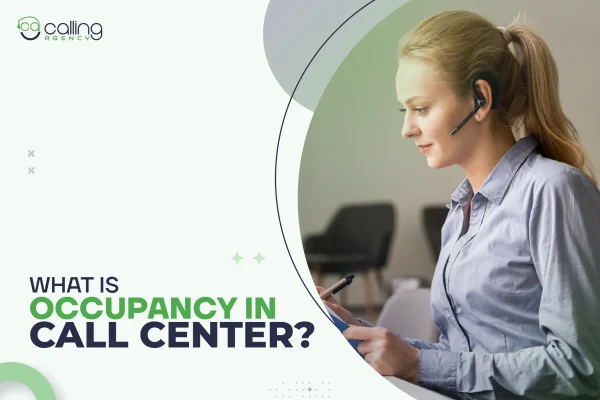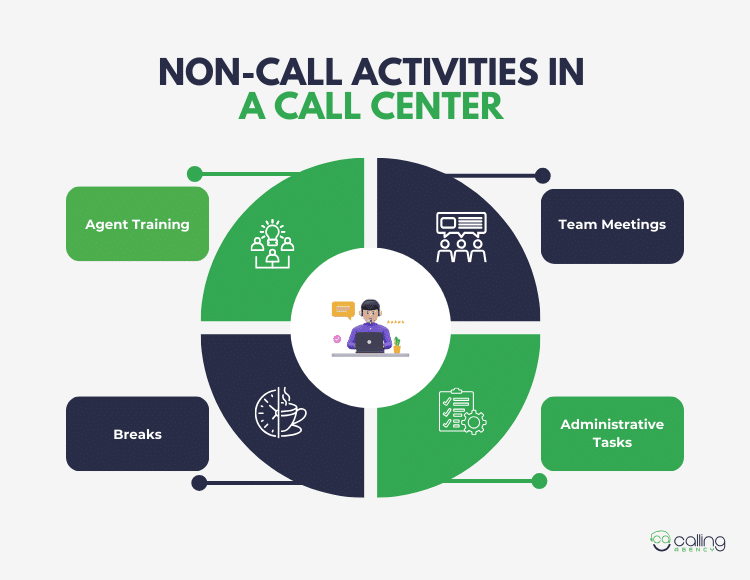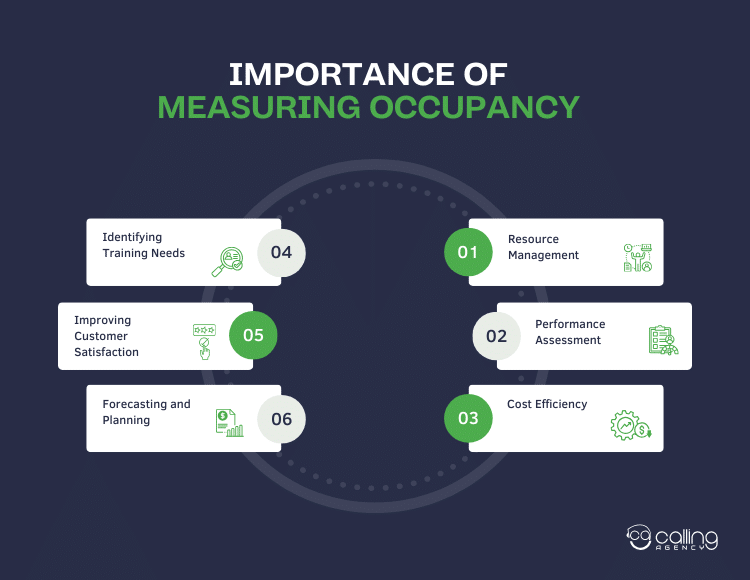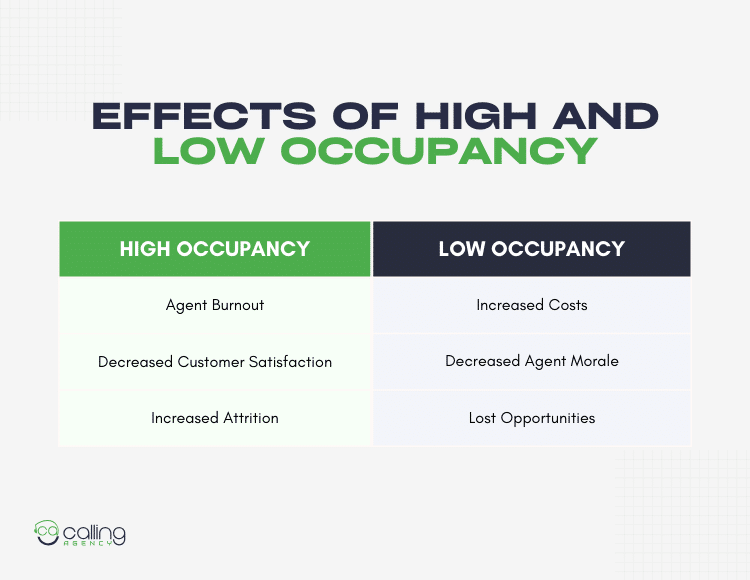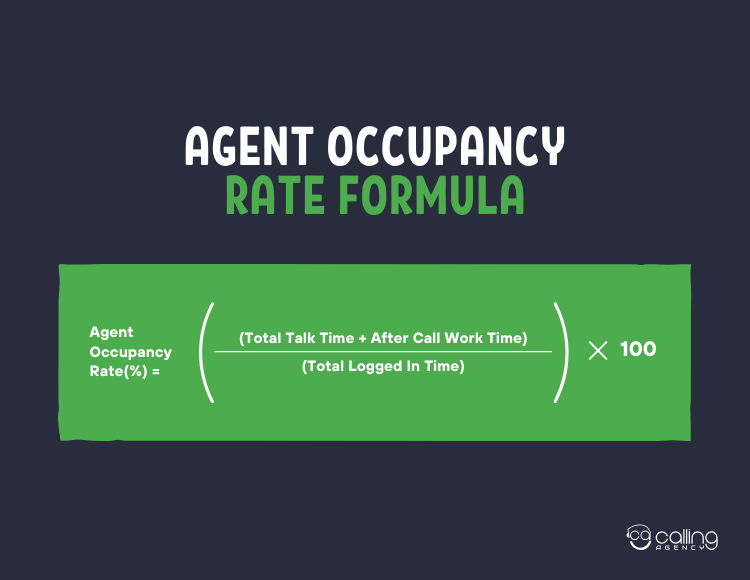In a call center context, “occupancy” refers to the percentage of time that call center agents spend actively handling customer interactions or performing work-related tasks compared to the total available time. It is a key performance indicator (KPI) that measures the efficiency and productivity of the call center staff.
Call centers use occupancy rates to optimize staffing levels and schedule breaks, and ensure that agents are effectively utilized. Monitoring and managing occupancy is crucial for maintaining high-quality customer service and employee satisfaction in a call center environment.
Let’s find out more about call center occupancy rates, why they are important, and how to improve them for your call center.
Call Center Occupancy Vs. Call Center Utilization
Many people think that occupancy and utilization are the same as both metrics measure agent productivity, and both are calculated as a percentage. However, they measure different aspects of an agent’s work time and are used for distinct purposes.
Occupancy is a measure of the time an agent spends handling calls or completing after-call work, divided by the total logged-in time. In other words, it’s the percentage of an agent’s logged-in time that is spent actively dealing with customers or the tasks associated with these interactions.
Utilization, on the other hand, measures the total time an agent spends on all work-related activities divided by the total time they are scheduled to work. It includes not only time spent on calls and after-call work but also time spent on breaks, training, meetings, and other non-call activities.
While occupancy focuses on the efficiency of call handling, utilization provides a comprehensive view of an agent’s overall workload. Both are crucial for managing a call center effectively, but they serve different purposes and should be interpreted in combination with each other.
Understanding the differences and utilizing these metrics can help you improve service levels in a call center and improve the call center’s overall performance.
What Is Utilization In Call Center?
Utilization in a call center is the percentage of time that agents spend actively handling customer interactions or tasks compared to the total available time. It is a key performance metric used to assess the efficiency and productivity of call center agents.
Utilization gives a more holistic view of how an agent’s time is spent during their shift. It helps managers ensure that agents are not being overworked and that non-call activities are not taking up an excessive amount of time.
Now, let’s take a look at some non-call activities agents have to deal with in a call center.
Training: Agent training includes any time spent on learning new skills, refreshing existing ones, or being updated on changes to products, services, or company policies.
Meetings: These could be team meetings, one-on-one meetings with supervisors, or any other type of official gathering that requires the agent’s participation.
Breaks: These may include scheduled breaks, lunch breaks, and any other downtime that is part of the agent’s work schedule.
Administrative Tasks: Administrative tasks are related to the job but not directly linked to handling customer calls. Examples include filling out timesheets, reading company updates, or completing performance assessments.
What is In Chair Occupancy and Phone Occupancy?
There are two specific types of occupancy metrics, “In-Chair Occupancy” and “Phone Occupancy.” Have a look at the general explanation of both types of occupancy.
In Chair Occupancy
In-chair occupancy is a metric that measures the total time an agent spends logged into the system, regardless of the activity they are engaged in. It includes time spent on calls, after-call work, training, meetings, breaks, and any other activities that occur while the agent is logged in.
It’s a measure of the total ‘in chair’ time, hence the name. This metric can provide insights into how much time agents are available and logged into the system, which can be useful for scheduling and workforce management.
Phone Occupancy
Phone occupancy, on the other hand, specifically measures the time an agent spends on the phone, handling customer calls. It does not include after-call work or any other activities – it’s purely the time spent talking to customers.
This metric is particularly useful for understanding the efficiency of call handling and can help identify opportunities for improving call handling processes or training needs.
Why Is Measuring Occupancy Important?
Occupancy plays a crucial role in understanding the efficiency of call-handling operations. Every call center should measure this key performance indicator to ensure smooth and productive operations. Here are some reasons why measuring occupancy is important.
- Occupancy rates can help managers understand how effectively agents’ time is being utilized. It can aid in making informed decisions about staffing levels, scheduling, and workload distribution.
- By monitoring occupancy rates, managers can identify trends and patterns in call handling. For instance, consistently high occupancy rates might indicate that agents are overloaded, which could impact their performance and lead to burnout.
- High occupancy rates mean agents are spending most of their time handling calls, which is what they are paid to do. It reflects cost efficiency. However, it’s important to balance this with the risk of overworking agents.
- If occupancy rates are low, it might indicate that agents are spending too much time on after-call work, possibly due to a lack of training or unclear procedures. It can help in identifying areas where additional training is needed.
- Effective management of occupancy rates can lead to reduced wait times, leading to improved customer satisfaction.
- Occupancy rates help significantly in call center forecasting and planning. It can be used for forecasting call volumes and planning staffing requirements.
What Are The Effects Of High And Low Occupancy?
A higher occupancy rate generally indicates better utilization of resources, as it means that agents are actively engaged in handling customer interactions for a significant portion of their available time.
However, excessively high occupancy rates may lead to agent burnout and increase call center attrition rates. So, it’s essential to strike a balance to stop decreasing agent performance. Now, let’s look into the detailed effects of occupancy in contact centers.
High Occupancy in Call Center
High occupancy rates in a call center mean that agents are spending a large proportion of their time handling calls or completing after-call work. While this might seem like a good thing as it indicates high productivity, it can have several negative effects as well.
- Constantly handling calls with little to no downtime can lead to stress and burnout, which can negatively impact an agent’s performance and well-being.
- When agents are rushed off their feet, the quality of service they provide can suffer. They may not have enough time to fully address a customer’s concerns, leading to decreased customer satisfaction.
- Higher stress levels and burnout can lead to higher attrition rates, which can be costly for call centers in terms of recruitment and training.
Low Occupancy in Call Center
Low occupancy rates mean that agents are spending a large proportion of their time idle, waiting for calls. It can cause several negative effects on a call center.
- Paying agents to sit idle is not cost-effective. Low occupancy rates can indicate that you are overstaffed and could adjust your scheduling to match your call volume better.
- Being idle can be demotivating for agents. They may feel that their skills are not being utilized effectively, which can lead to decreased job satisfaction.
- Time spent idle could be used for other productive activities, such as training or coaching.
The Right Occupancy For Your Contact Center
Finding the right balance for your contact center is crucial. The ideal occupancy rate can depend on various factors, including the nature of your calls, the skill level of your agents, your call center services, and your specific business objectives.
However, many industry experts suggest an occupancy rate of around 85% as a good balance between efficiency and agent well-being. This rate allows for a high level of productivity while still giving agents some breathing room between calls. It will improve call center agent performance and increase customer satisfaction.
Agent Occupancy Formula
Agent occupancy is calculated by dividing the total time an agent spends on call-related activities by the total time they are logged in. The formula to calculate the agent occupancy rate is as follows:
Agent Occupancy Rate(%) = (Total Talk Time + After Call Work Time) / (Total Logged In Time) x 100
Total talk time is the total time an agent spends talking to customers on the phone, and after-call work time is the time an agent spends on tasks associated with the call after the call has ended. It includes things like updating customer records, sending follow-up emails, or discussing the call with a supervisor.
The total logged-in time is the total time an agent is logged into the call handling system, regardless of what activities they are engaged in.
So, agent occupancy can simply be calculated by dividing the time an agent spends on calls by their total working time, then multiplying the result by 100 to get a percentage.
For example, an agent working on cold calling services at a call center spent 389 minutes on handling calls or other call-related activities during his 448 minutes logged-in time.
So, that agent would have an occupancy rate of (389/448) x 100 = 86.8%.
Ideal Occupancy Rate For Call Center
Call centers will face difficulties if the occupancy rate for a call center is permanently close to 100%. If this situation arises, the customer queue will get out of control or explode. So, what is the ideal occupancy rate for a call center? The answer is between 80% and 90%.
An occupancy rate between 80% to 90% suggests that agents are spending the majority of their time handling calls but also have some breathing room for after-call work and short breaks. It can help maintain high levels of productivity while also preventing burnout and ensuring high-quality customer service.
How to Improve Call Center Occupancy
Improving call center occupancy is a key aspect of improving overall productivity and efficiency. You need to accurately monitor the call volumes of your call center to improve the occupancy rate.
Use historical data and predictive analytics to accurately forecast call volumes and schedule agents accordingly. It can help ensure that you have the right number of agents available at the right times, which can improve occupancy rates.
Furthermore, ensure that calls are routed to the most appropriate agent based on factors like skill level, availability, and call type. Optimizing call routing can help reduce hold times and after-call work, thereby increasing occupancy.
You also have to provide comprehensive training to agents so they can handle calls more efficiently. 40% of customers want better training for the customer service agents. Training on the use of call handling systems, product knowledge, and soft skills like communication and problem-solving can improve your call center’s occupancy rates.
Moreover, you have to use advanced call center technologies like automatic call distributors (ACD), interactive voice response (IVR) systems, and workforce management software. These tools can help streamline call-handling processes and improve occupancy rates.
Regularly monitor agent performance and provide constructive feedback. Monitoring performance and providing feedback can help identify areas for improvement and motivate agents to work more efficiently.
Finally, encourage agents to take their breaks during low-volume periods. It ensures that most agents are available during peak times. Breaks can decrease the stress of the agents and increase occupancy.
Final Thoughts
Understanding and effectively managing occupancy is key to running a successful call center. Occupancy in call centers can maximize agent productivity, deliver excellent customer service, and achieve operational efficiency.
However, it’s important to maintain the balance between keeping agents productive and not overworked. A happy agent can effectively satisfy customers. So, try to find the balance that works best for your team and your customers.
Also, occupancy is an evolving process where call centers need to adapt to continuous changes. Lastly, follow the provided tips precisely to improve call center occupancy.

